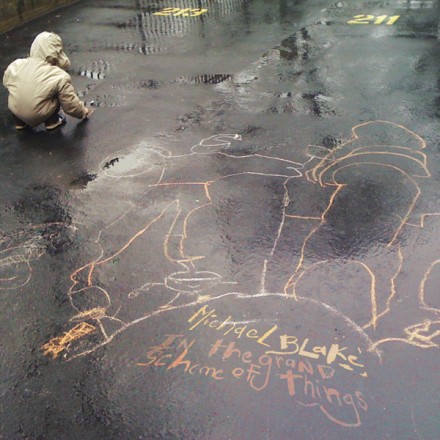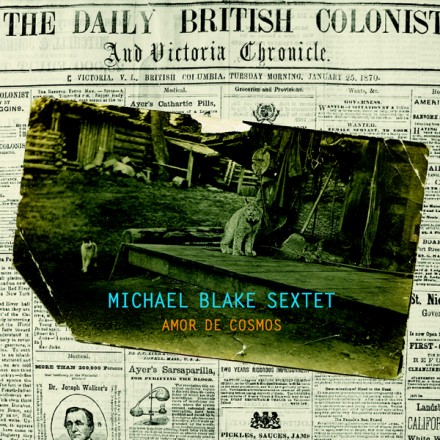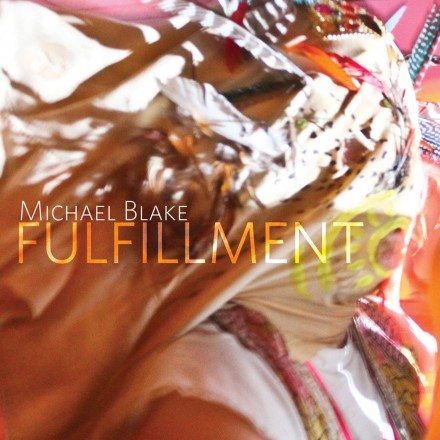Michael Blake
In the Grand Scheme of Things
SGL 1598-2Amor de Cosmos (2007) was Michael Blake’s first record created for a Canadian group – although he’s from Vancouver originally he’s lived and built his career in New York over the last 25 years. His new Variety Hour quartet retains dexterous Vancouver keyboardist Chris Gestrin and masterful, internationally acclaimed drummer Dylan van der Schyff while adding the idiosyncratic JP Carter (Inhabitants, Fond of Tigers, Destroyer, Dan Mangan) on trumpet and electronics. All three are equally adept in relatively straight-ahead to totally free contexts. They have an intuitive connection from many years’ playing in various bands, and they take Blake’s music to unexpected places. Says Michael: “I feel very comfortable with these musicians. It’s in the way they leave space, suggest motives with the simplest of gestures and listen to each other. I feel at home and I’m embracing that.”
One unusual aspect of this quartet is the fact that Gestrin is playing both Rhodes and Micromoog bass (he also recorded and mixed the sessions, beautifully). “Chris is without a doubt a world-class artist and his Moog playing on IGST is exemplary. His independence on both keyboards is obvious, but how he engages both instruments in conversation is really amazing. He really makes it sound like we have another person playing bass.”
“After our first shows I began to write tunes that I thought would work well with the Moog. ‘The Variety Hour’ is a good example of that. Dylan came up with the groove for ‘Road to Lusaka’. There are many examples of this open-ended style of arranging because I want the band to participate in the construction of the pieces. That’s why we sound like a band! I admired and studied how Miles Davis did it, especially after his music got more freeform. I prefer to let things flow and a lot of notation can hinder that.” It’s notable that the title suite was written in one afternoon – though not for this group – and recorded in a single take, its sections linked by improvs.
Throughout, Michael is there, shaping the music’s emotional qualities. It’s a cliche to call certain kinds of moody, atmospheric jazz ‘cinematic’, but it’s also true that Michael is a film fan, has composed for film, and is interested in music that speaks directly to our shared human experience. “I am obsessed with how a chord progression changes the way a melody feels to the listener. For example on ‘Willie’ I wrote mostly major and minor triads but the mood of the tune changes in relationship to what melody note is played within each chord. Simply inverting a chord from major to minor can alter the color enough to satisfy my need for substance. Also, voice leading in a way so that one or two notes sustain while the root tonality is altered really appeals to me. This is a very common tool in many film scores. I am seeking an emotional response that is very intentional and quite manipulative too. Another example of that in ‘Willie’ is at the end of the melody: I asked Chris to repeat the last three chords and it creates a sort of melancholia that wouldn’t work earlier on in the piece. But after the free-spirited tenor solo we need to reset the mood and retain some of that feeling we got earlier on. Willie is a lonely cowboy, after all. I try to compose ideas that contain fragments of things that we can all relate to – like memories, predictions and whatever is happening in the moment…No words are required, and every listener can still follow a dialogue that is being expressed through melodic, thematic and lyrical improvisation.”
As for the Otis Redding cover “Treat Her Right,” Michael comments: “I love to play classics. It’s perhaps a generational thing I picked up from friends in NYC. Long before The Bad Plus came along Steven Bernstein’s band Sex Mob led the way covering pop and rock tunes. My friend guitarist David Tronzo heard me playing like King Curtis and we started a band (Slow Poke) that played mostly covers. I learned a lot about playing melodies from these guys. It’s almost a lost art, and many of us feel committed to carrying on this tradition that stems from Ellington and early jazz. My inspiration on ‘Treat Her Right’ was to phrase like Otis with the hefty warm tone of the great tenorman Gene Ammons. In my opinion there’s a good way to play blues and soul on the sax…and it’s hard! Most players (myself included) get so wrapped up in pyrotechnics and mimicking iconic players that they forget how to play the melody.”


